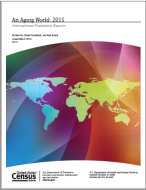
An official website of the United States government
Here’s how you know
Official websites use .gov
A .gov website belongs to an official government organization in the United States.
Secure .gov websites use HTTPS
A lock (
) or https:// means you’ve safely connected to the .gov website. Share sensitive information only on official, secure websites.
-
//
- Census.gov /
- Library /
- Publications /
- An Aging World: 2015
An Aging World: 2015
An Aging World: 2015
Introduction
The world population continues to grow older rapidly as fertility rates have fallen to very low levels in most world regions and people tend to live longer. When the global population reached 7 billion in 2012, 562 million (or 8.0 percent) were aged 65 and over. In 2015, 3 years later, the older population rose by 55 million and the proportion of the older population reached 8.5 percent of the total population. With the post World War II baby boom generation in the United States and Europe joining the older ranks in recent years and with the accelerated growth of older populations in Asia and Latin America, the next 10 years will witness an increase of about 236 million people aged 65 and older throughout the world. Thereafter, from 2025 to 2050, the older population is projected to almost double to 1.6 billion globally, whereas the total population will grow by just 34 percent over the same period.
Yet the pace of aging has not been uniform. A distinct feature of global population aging is its uneven speed across world regions and development levels. Most of the more developed countries in Europe have been aging for decades, some for over a century. In 2015, 1 in 6 people in the world live in a more developed country, but more than a third of the world population aged 65 and older and over half of the world population aged 85 and older live in these countries. The older populations in more developed countries are projected to continue to grow in size, but at a much slower pace than those in less developed countries, particularly in Asia and Latin America. By 2050, less than one-fifth of the world’s older population will reside in more developed countries.
There are great variations within the less developed world as well. Asia stands out as the population giant, given both the size of its older population (617.1 million in 2015) and its current share of the world older population (more than half). By 2050, almost two-thirds of the world’s older people will live in Asia. Even countries experiencing slower aging will see a large increase in their older populations. Africa, for instance, is projected to still have a young population in 2050 (with those at older ages projected to be less than 7 percent of the total regional population), yet the projected 150.5 million older Africans would be almost quadruple the 40.6 million in 2015.
Population aging, while due primarily to lower fertility, also reflects a human success story of increased longevity. Today, living to age 70 or age 80 is no longer a rarity in many parts of the world. However, increasing longevity has led to new challenges: How many years can older people expect to live in good health? What are the chronic diseases that they may have to deal with? How long can they live independently? How many of them are still working? Will they have sufficient economic resources to last their lifetimes? Can they afford health care costs? The world is facing these and many more questions as population aging continues.
Others in Series
Publication
Publication
Publication
Share
Related Information
Some content on this site is available in several different electronic formats. Some of the files may require a plug-in or additional software to view.
 Yes
Yes
 No
NoComments or suggestions?


Top

